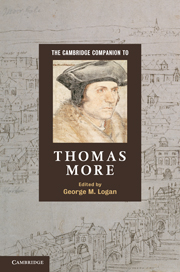Book contents
4 - More’s public life
from Part I - Life, times and work
Published online by Cambridge University Press: 28 May 2011
Summary
In an act of characteristic prescience and with lawyerly clarity, More composed his own epitaph, which he had cut in stone and which survives to this day in Chelsea Old Church. It was the month following his resignation as lord chancellor of England, some eight months before King Henry VIII sought his arrest and two years before his execution. He sent a copy with a letter of explanation (in Latin, like the epitaph) to his great Dutch friend Erasmus for publication and dissemination on the Continent, describing the epitaph as ‘a public declaration of the actual facts’, which anyone could refute if they were able (SL 178–83, at 179). In the epitaph More presents himself as a Londoner, alludes briefly to his literary interests and underscores his several years spent as a pleader in the law courts. He then lists his various public offices, duties and particular achievements in an admirably compressed form which conveys much about the period 1518–32, which primarily concerns this chapter:
[A]fter having held the office of judge as an Under-Sheriff in his
native city, he was admitted to the Court by the Unconquerable
Henry the Eighth, who is the only King ever to have received the
unique distinction of meriting the title ‘Defender of the Faith’, a
title earned by deeds of sword and pen; he was received at
Court, chosen member of the King’s Council, knighted, appointed
Under-Treasurer and then Chancellor of Lancaster, and finally,
Chancellor of England by the special favor of his Sovereign.
Meanwhile he was elected Speaker of the House of Commons;
furthermore, he served as the King’s ambassador at various times
and in various places, last of all at Cambrai.
(SL 181)- Type
- Chapter
- Information
- The Cambridge Companion to Thomas More , pp. 69 - 92Publisher: Cambridge University PressPrint publication year: 2011

